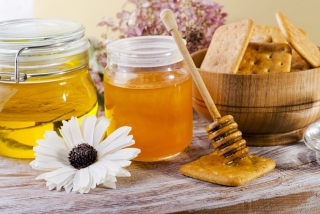
Honey’s Natural Sweetness Delivers Diverse Flavor Profiles in Bakery Foods
30 September 2016Not only is honey sweeter than sugar, it also softens baked goods and can extend a product’s shelf life. The National Honey Board’s Keith Seiz finds inspiration from honey.
By Keith Seiz, Ingredient Marketing Representative, National Honey Board
Finding Pure Inspiration from Honey
It’s an interesting time in the sweetener industry, especially in bakery foods. There are countless diet and nutritional trends that have impacted how bakery foods are formulated and marketed. Simply put, food is no longer just food. It’s science, medicine, entertainment and more. It’s something that’s analyzed and dissected constantly, and sweeteners have come under more scrutiny than most other ingredients.
Honey is meeting the sweetener demands of consumers by allowing bakers to produce exceptional products with a sweetener that has a positive perception with consumers, and delivers countless functional and flavor benefits. That is unique in any ingredient, and especially with a sweetener, which is why honey’s popularity is increasing in the baking and snack industries.
From Sweetness to Flavor
Honey’s use in the baking industry is timeless. It’s also innovative, creative and functional. Most importantly, it’s inspirational. As an all-natural sweetener, it opens boundless new product development opportunities in breads, cookies, cakes, rolls, sweet goods, bars and more.
Honey is mainly used by the baking industry to deliver sweetness to a product. Honey can be anywhere from 1x to 1.5x sweeter than sugar. In addition to this sweetening, honey also can be used to provide a strong flavor component to bakery foods.
There are more than 300 different types of honey in the United States alone, each with a unique flavor profile that is dependent on the nectar source or flower where the bee foraged. This flavor versatility gives bakers the opportunity to use honey not only for its functional and sweetening benefits, but also to achieve a very specific flavor profile.
If a baker wanted a strong, robust flavor profile, they can use a darker honey, such as buckwheat. If they want a more delicate, sweet profile, they could use Orange Blossom or Clover. Below are some of the most common varietals and how they can be used in bakery food formulas.
- Orange Blossom: A combination of citrus floral sources, orange blossom honey is prominently sourced from Florida, Texas, Arizona and California. It’s light, delicate flavor carries hints of citrus flavor and aroma, and pairs perfectly in almost every bakery food.
- Tupelo: A popular song and honey, Tupelo honey comes from trees found mainly in southern Georgia and northwestern Florida. The color is very light, and the flavor is exceptionally delicate. It’s the perfect honey to use in a glaze or filling.
- Buckwheat: A very dark, robust honey with a surprising flavor often described as earthy and malty. It’s the perfect addition to artisan breads that crave a complex flavor profile and rich, dark color.
- Blueberry: Taken from the tiny white flowers of the blueberry bush, the nectar makes a honey that is typically light amber in color with a full, well-rounded flavor.
- Sourwood: Despite its name, this honey is far from sour. Instead, its sweet flavor profile is balanced by notes of spiciness, including cinnamon and anise. It’s the perfect honey for sweet breads and any products prepared for the holidays.
Despite these many flavors, honey’s essence is its natural simplicity. Honey is primarily composed of fructose, glucose and water. It also contains other sugars as well as trace enzymes, minerals, vitamins and amino acids.
The sweetener is not created or manufactured in a facility. It occurs naturally in one of the world’s most efficient factories: the beehive. Bees may travel as far as 55,000 miles and visit more than two million flowers to gather enough nectar to make just one pound of honey. All of the bees’ hard work is manifested in an amazing ingredient ideal for use in bakery food formulas.
Honey’s Role in Bakery Foods
In addition to flavor and sweetness, honey also plays important functional roles in bakery foods:
- Humectancy: Honey’s fructose content helps bakery foods hold in moisture and extends shelf life. This reduces dryness and crumbliness, making for a more acceptable finished product.
- Extended Shelf Life: The high acidity of honey (average pH 3.91) helps inhibit mold growth. Research has documented honey’s ability to soften bakery foods, inhibit staling and extend shelf life.
- Flavor Enhancement: Naturally occurring organic acids in honey, such as gluconic acid, enhance the flavors of spices, fruits and nuts. When used with cinnamon, herbs, spices or other flavors, honey helps bring out those tastes and aromas.
- Natural Color: Honey sugars caramelize during baking and add a golden color to artisan breads.
- Viscosity: Honey naturally coats, binds and thickens products, improving mouthfeel.
- Masking: Honey has become an essential ingredient when formulating products with whole grains, because the sweetener smooths out any off flavors and creates an exceptional flavor profile.
Honey Usage Guidelines
When baking with honey, follow these guidelines to ensure exceptional products:
- Honey’s acidic nature requires the addition of a small amount of baking soda (about 0.2 ounces or one teaspoon of baking soda per 12 ounces or one cup of honey).
- Honey can replace up to one-half of the granulated sugar in a recipe, and in some bakery foods, honey can replace all of the sugar.
- Reduce the liquid called for in a formula by one-quarter cup (2 ounces) for each cup (12 ounces) of honey used.
- When honey is added to a formula, reduce oven temperatures by 25°F to prevent over-browning.
The National Honey Board is an industry-funded agriculture promotion group that works to educate consumers about the benefits and uses for honey and honey products through research, marketingand promotional programs. For more information, visit http://www.honey.com/.
Photo courtesy of the National Honey Board.